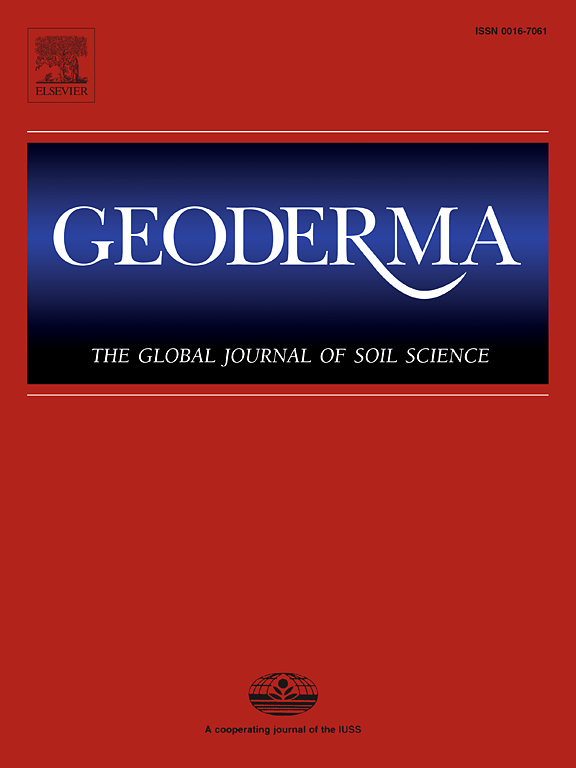Monitoring soil cracking using OFDR-based distributed temperature sensing framework
IF 5.6
1区 农林科学
Q1 SOIL SCIENCE
引用次数: 0
Abstract
Soil cracking induced by extreme drought represents a widespread natural phenomenon occurring across the earth surface, capable of triggering multiple weakening mechanisms within surface soils, potentially leading to the instability and failure of slopes and agricultural infrastructures. This study proposes an innovative geophysical monitoring framework for detecting field soil cracking by combining the actively heated fiber-optic (AHFO) method and distributed fibre optical sensing (DFOS) based on optical frequency domain reflectometry (OFDR) technique, referred to as AH-OFDR framework. Laboratory calibration tests, field monitoring tests, numerical simulations, and sensitivity analyses were employed to comprehensively evaluate the feasibility, effectiveness, and limitations of the AH-OFDR framework for soil crack monitoring. Laboratory calibration confirmed that the DFOS-OFDR technique achieves a minimum spatial resolution and readout accuracy of 1 mm, along with a temperature measurement accuracy of ±0.1 °C. Field monitoring verified that the AH-OFDR framework can accurately detect soil cracks ranging in width from 0.01 m to 0.12 m. Additionally, numerical simulations not only validated the effectiveness of the AH-OFDR framework across a broader range of crack widths, from 0.01 m to 0.50 m, but also established a quantitative relationship between temperature changes and the spatial distribution of crack positions and widths. Notably, a critical crack width threshold of 0.30 m was identified within the AH-OFDR framework, significantly impacting the prediction of soil crack widths. Sensitivity analysis demonstrated the remarkable crack detection capabilities of the AH-OFDR framework, irrespective of the soil crack width and spacing. The AH-OFDR framework holds substantial potential as an innovative and high-resolution observational method for advancing our understanding of diverse geological and hydrogeological processes.
利用基于 OFDR 的分布式温度传感框架监测土壤裂缝
极端干旱引起的土壤开裂是一种普遍存在于地球表面的自然现象,能够引发地表土壤的多种弱化机制,可能导致边坡和农业基础设施的不稳定和破坏。本研究提出了一种创新的地球物理监测框架,通过结合主动加热光纤(AHFO)方法和基于光频域反射仪(OFDR)技术的分布式光纤传感(DFOS)来检测野外土壤开裂,简称为 AH-OFDR 框架。通过实验室校准试验、现场监测试验、数值模拟和灵敏度分析,全面评估了 AH-OFDR 框架用于土壤裂缝监测的可行性、有效性和局限性。实验室校准证实,DFOS-OFDR 技术的最小空间分辨率和读出精度为 1 毫米,温度测量精度为 ±0.1 °C。此外,数值模拟不仅验证了 AH-OFDR 框架在从 0.01 米到 0.50 米的更大裂缝宽度范围内的有效性,还确定了温度变化与裂缝位置和宽度的空间分布之间的定量关系。值得注意的是,AH-OFDR 框架确定了 0.30 米的临界裂缝宽度阈值,对土壤裂缝宽度的预测产生了重大影响。敏感性分析表明,无论土壤裂缝宽度和间距如何,AH-OFDR 框架都具有出色的裂缝检测能力。作为一种创新的高分辨率观测方法,AH-OFDR 框架具有巨大的潜力,可促进我们对各种地质和水文地质过程的了解。
本文章由计算机程序翻译,如有差异,请以英文原文为准。
求助全文
约1分钟内获得全文
求助全文
来源期刊

Geoderma
农林科学-土壤科学
CiteScore
11.80
自引率
6.60%
发文量
597
审稿时长
58 days
期刊介绍:
Geoderma - the global journal of soil science - welcomes authors, readers and soil research from all parts of the world, encourages worldwide soil studies, and embraces all aspects of soil science and its associated pedagogy. The journal particularly welcomes interdisciplinary work focusing on dynamic soil processes and functions across space and time.
 求助内容:
求助内容: 应助结果提醒方式:
应助结果提醒方式:


